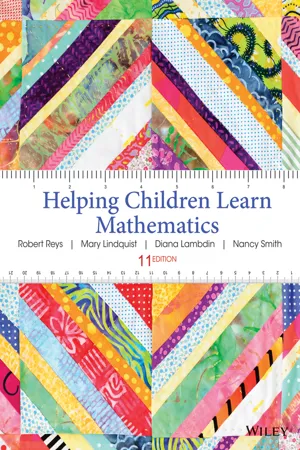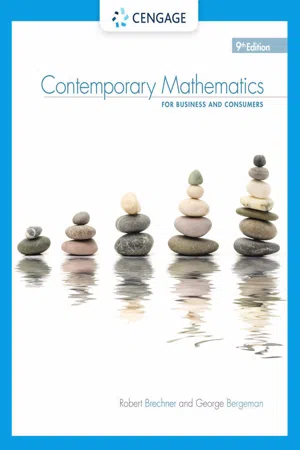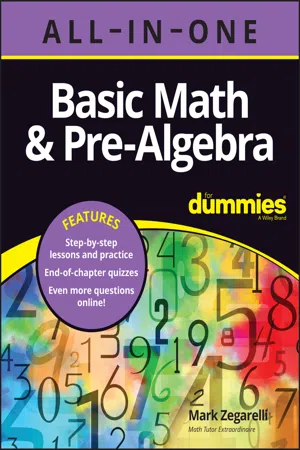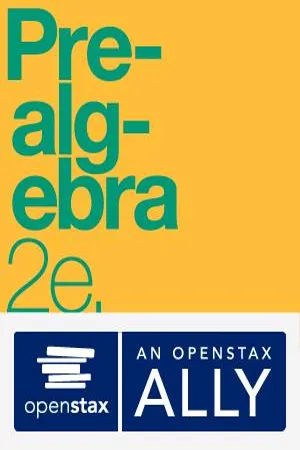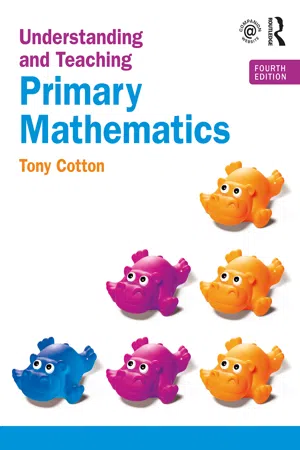Mathematics
Percentage
Percentage is a way of expressing a number as a fraction of 100. It is often used to compare quantities or represent proportions. In mathematics, percentages are commonly used in calculations involving taxes, discounts, and interest rates. They are denoted by the symbol "%," and can be converted to fractions or decimals for mathematical operations.
Written by Perlego with AI-assistance
Related key terms
1 of 5
9 Key excerpts on "Percentage"
- eBook - PDF
- Robert Reys, Mary Lindquist, Diana V. Lambdin, Nancy L. Smith, Anna Rogers, Audrey Cooke, Bronwyn Ewing, Kylie Robson(Authors)
- 2021(Publication Date)
- Wiley(Publisher)
Luckily, this provides great opportunities for providing context for the mathematics that is completed with the use of real-world problems that utilise Percentage. As is true with decimals and fractions, Percentages express a relationship between two numbers. Percentages are special ratios based on 100 and without a doubt are the most widely used of all ratios. Per cent is derived from the Latin words per centum, which mean ‘out of a hundred’ or ‘for every hundred’. Thus, the origin of Percentage and its major uses are closely associated with ratio, fractions and decimals. Thus 25% is the ratio 25:100 or 25 100 , which then connects to the decimal (0.25) and the fraction 1 4 . When is Percentage understood? Children understand Percentage when they can use it in many different ways. For instance, if a child understands 25%, he or she can do the following tasks. • Find 25% in various contexts. – Cover 25% of a floor with tiles. – Determine 25% off the price of a given item. – Survey 25% of the children in class. In many such situations, estimates of 25% are valuable but exactness would be required in some settings (such as at stores). • Identify characteristics of 25%. – 25% of the milk in a glass is less than half. – If 25% of the milk in a glass is spilled, then 75% remains. • Compare and contrast 25% with a range of other Percentages and numbers such as 5%, 50%, 100%, one-quarter, one-half and 0.25. – 25% is half as much as 50%, one-quarter as much as 100%, five times as much as 5%, less than one-half, and the same as one-quarter and 25 hundredths. Early development of Percentage can be facilitated with literature connections. For example, If the World Were a Village (Smith, 2008) provides data and a relevant context to consider the meaning of Percentage. - eBook - PDF
- Robert Reys, Mary Lindquist, Diana V. Lambdin, Nancy L. Smith(Authors)
- 2014(Publication Date)
- Wiley(Publisher)
These percents should be illustrated with a variety of different situations and models. For example, a rope with 100 disks arranged in multiples of 10 in alternating colors shows 50% of each color. • Can a price increase 150%? • Can a price decrease 50%? • Can a price decrease 100%? • Can a price decrease 150%? Ironically, the understanding of percent requires no new skills or concepts beyond those used in mastering fractions, decimals, ratios, and proportions. In fact, percent is not really a mathematical topic, but rather the application of a particu- lar type of notational system. The justification for teaching percent in school mathematics programs rests solely on its social utility. As is true with decimals and fractions, percents express a relationship between two numbers. Percents are special ratios based on 100 and without a doubt are the most widely used of all ratios. Percent is derived from the Latin words per centum, which mean “out of a hundred” or “for every hundred.” The origin of percent and its major uses are close- ly associated with ratios, fractions, and decimals. Thus, 25% is the ratio 25:100 or 25 100 , which then connects to decimals (0.25) and the fraction 1 4 . When is percent understood? Students understand per- cent when they can use it in many different ways. For instance, if a child understands 25%, he or she can do the following tasks. • Find 25% in various contexts: Cover 25% of a floor with tiles. Determine 25% off the price of a given item. Survey 25% of the students in class. In many such situations, estimates of 25% are not only ap- propriate but essential. • Identify characteristics of 25%: 25% of the milk in a glass is less than half. If 25% of a glass is spilled, then 75% remains. • Compare and contrast 25% with a range of other percents and numbers such as 5%, 50%, 100%, one-fourth, one-half, and 0.25. - Robert Brechner, Geroge Bergeman(Authors)
- 2019(Publication Date)
- Cengage Learning EMEA(Publisher)
Percents are the primary way of measuring change among business variables. For example, a business might report “revenue is up 6% this year” or “expenses have been cut by 2.3% this month.” Interest rates, commis-sions, and many taxes are expressed in percent form. You may have heard phrases like these: “Sunnyside Bank charged 12% on the loan,” “A real estate broker made 5% commission on the sale of the property,” or “The state charges a 6 1 2 % sales tax.” Even price changes are frequently advertised as percents, “Sears Dishwasher Sale—All Models, 25% off!” To this point, we have learned that fractions and decimals are ways of representing parts of a whole. Percents are another way of expressing quantity with relation to a whole. Percent means “per hundred” or “parts per hundred” and is represented by the percent sign , % . Percents are numbers equal to a fraction with a denominator of 100 . Five percent, for example, means five parts out of 100 and may be written in the following ways: 5 percent 5% 5 hundredths 5 100 .0 5 Before performing any mathematical calculations with percents, they must be converted to either decimals or fractions. Although this function is performed automatically by the percent key on a calculator, Section I of this chapter covers the procedures for making these conversions manually. Sections II and III introduce you to some important applications of percents in business. C ONVERTING P ERCENTS TO D ECIMALS AND D ECIMALS TO P ERCENTS Because percents are numbers expressed as parts per 100 , the percent sign, % , mean multi- plication by 1 100 . Therefore, 25% means 2 5% = 25 × 1 100 = 25 100 = .2 5 percent A way of representing the parts of a whole. Percent means “per hundred” or “parts per hundred.” percent sign The symbol, % , used to represent percents. For example, 1 percent would be written as 1% . 6-1 EXAMPLE 1 CONVERTING PERCENTS to deCimals Convert the following percents to decimals.- Mark Zegarelli(Author)
- 2022(Publication Date)
- For Dummies(Publisher)
You can say that “50 out of 100” children are girls — or you can shorten it to simply “50 percent.” Even shorter than that, you can use the symbol %, which means percent. Saying that 50% of the students are girls is the same as saying that 1 2 of them are girls. Or if you prefer decimals, it’s the same thing as saying that 0.5 of all the students are girls. This example shows you that Percentages, like fractions and decimals, are just another way of Chapter 14 IN THIS CHAPTER » Understanding what Percentages are » Converting Percentages back and forth between decimals and fractions » Solving both simple and difficult Percentage problems » Using equations to solve three different types of Percentage problems 286 UNIT 5 Decimals and Percents talking about parts of the whole. In this case, the whole is the total number of children in the school. You don’t literally have to have 100 of something to use a percent. You probably won’t ever really cut a cake into 100 pieces, but that doesn’t matter. The values are the same. Whether you’re talking about cake, a dollar, or a group of children, 50% is still half, 25% is still one- quarter, 75% is still three-quarters, and so on. Any Percentage smaller than 100% means less than the whole — the smaller the Percentage, the less you have. You probably know this fact well from the school grading system. If you get 100%, you get a perfect score. And 90% is usually A work, 80% is a B, 70% is a C, and, well, you know the rest. Of course, 0% means “0 out of 100” — any way you slice it, you have nothing. Dealing with Percentages Greater than 100% The term 100% means “100 out of 100” — in other words, everything. So when I say I have 100% confidence in you, I mean that I have complete confidence in you. What about Percentages more than 100%? Well, sometimes Percentages like these don’t make sense.- eBook - PDF
- Lynn Marecek, MaryAnne Anthony-Smith, Andrea Honeycutt Mathis(Authors)
- 2020(Publication Date)
- Openstax(Publisher)
A percent is a ratio whose denominator is 100. We use the percent symbol %, to show percent. Percent A percent is a ratio whose denominator is 100. According to data from the American Association of Community Colleges (2015), about 57% of community college students are female. This means 57 out of every 100 community college students are female, as Figure 6.2 shows. Out of the 100 squares on the grid, 57 are shaded, which we write as the ratio 57 100 . Figure 6.2 Among every 100 community college students, 57 are female. Similarly, 25% means a ratio of 25 100 , 3% means a ratio of 3 100 and 100% means a ratio of 100 100 . In words, "one hundred percent" means the total 100% is 100 100 , and since 100 100 = 1, we see that 100% means 1 whole. EXAMPLE 6.1 According to the Public Policy Institute of California (2010), 44% of parents of public school children would like their youngest child to earn a graduate degree. Write this percent as a ratio. Solution The amount we want to convert is 44%. 44% Write the percent as a ratio. Remember that percent means per 100. 44 100 TRY IT : : 6.1 Write the percent as a ratio. According to a survey, 89% of college students have a smartphone. TRY IT : : 6.2 Write the percent as a ratio. A study found that 72% of U.S. teens send text messages regularly. 518 Chapter 6 Percents This OpenStax book is available for free at http://cnx.org/content/col30939/1.6 EXAMPLE 6.2 In 2007, according to a U.S. Department of Education report, 21 out of every 100 first-time freshmen college students at 4-year public institutions took at least one remedial course. Write this as a ratio and then as a percent. Solution The amount we want to convert is 21 out of 100 . 21 out of 100 Write as a ratio. 21 100 Convert the 21 per 100 to percent. - Jo Boaler, Jen Munson, Cathy Williams(Authors)
- 2019(Publication Date)
- Jossey-Bass(Publisher)
BIG IDEA 4 Understanding Percents in the WorldA recent survey in the UK found that 20% of adults did not know how to use Percentages. If my experience in life is anything to go by, the number of people confused by Percentages may be much higher. Judging from conversations with many people—children and adults—it seems that they are not unclear about how to enact a procedure but rather are confused by the different uses of Percentages that involve completely different calculations. The typical problem is that people do not know how to set up the calculation. Often when we help students, we skim over the differences between different uses of Percentage and instead talk through what to do in each case. But it is the setting up of the method to use that is hardest.The two main differences in the uses of Percentage are these. In some situations, we need to calculate a Percentage of something—for example, this sale item has 25% off its original price of $140. In that situation, we are calculating × 140. That calculation involves dividing by 100. But in other situations, we are told two values and asked questions such as, What is as a Percentage? In that situation we do the opposite: we multiply by 100 ( × 100 gives us 60%). If students only learn to perform calculations—sometimes dividing by 100 and sometimes multiplying by 100—but never stop to think conceptually about what is different in the two situations and why the calculations are different, they are bound to become confused. When they meet Percentages in life, often people do not know which calculation to use.In our Visualize activity, we ask students to first look at a Mondrian-style piece of art and determine the percent of each color for the painting. Our goal is for students to engage flexibly with number and percent and also connect percent to area. In the piece of art, the areas for the same colors are not adjacent, nor are they the same size. This will encourage students to visually work through determining the whole and parts of the whole and then move to percent. This is important for later study in high school, and it is a common theme on standardized tests. Students are asked to work out their own methods. After working in groups, they will later share their methods and learn from each other. Afterward they will design their own work of art for others to study and enjoy.- eBook - PDF
- Alan Tussy, Diane Koenig(Authors)
- 2018(Publication Date)
- Cengage Learning EMEA(Publisher)
How much money will be in the account at the end of 1 year? Copyright 2019 Cengage Learning. All Rights Reserved. May not be copied, scanned, or duplicated, in whole or in part. Due to electronic rights, some third party content may be suppressed from the eBook and/or eChapter(s). Editorial review has deemed that any suppressed content does not materially affect the overall learning experience. Cengage Learning reserves the right to remove additional content at any time if subsequent rights restrictions require it. CHAPTER 7 • Percent 698 1 DEFINITIONS AND CONCEPTS EXAMPLES Percent means parts per one hundred. The word percent can be written using the symbol %. In the figure below, there are 100 equal-sized square regions, and 37 of them are shaded. We say that 37 100 , or 37 %, of the figure is shaded. Numerator 37 100 37 % Per 100 To write a percent as a fraction, drop the % symbol and write the given number over 100. Then simplify the fraction, if possible. Write 22 % as a fraction. 22 % 22 100 Drop the % symbol and write 22 over 100. 2 1 ? 11 2 1 ? 50 To simplify the fraction, factor 22 and 100. Then remove the common factor of 2 from the numerator and denominator. Thus, 22 % 11 50 . Percents such as 9.1 % and 36.23 % can be written as fractions of whole numbers by multiplying the numerator and denominator by a power of 10. Write 9.1 % as a fraction. 9.1 % 9.1 100 Drop the % symbol and write 9.1 over 100. 9.1 100 ? 10 10 To obtain an equivalent fraction of whole numbers, we need to move the decimal point in the numerator one place to the right. Choose 10 10 as the form of 1 to build the fraction. 91 1,000 Multiply the numerators. Multiply the denominators. Thus, 9.1 % 91 1,000 . WRITING 69. What is the difference between simple and compound interest? 70. Explain this statement: Interest is the amount of money paid for the use of money. 71. On some accounts, banks charge a penalty if the depositor withdraws the money before the end of the term. - Mary M. Hatfield, Nancy Tanner Edwards, Gary G. Bitter, Jean Morrow(Authors)
- 2012(Publication Date)
- Wiley(Publisher)
What are the next steps you need to do to help all the students continue to grow? 8. Share your thoughts with others. See what your com- bined knowledge might be able to create. SUMMARY Percent, ratio, proportion, and rate involve a multiplicative relationship and a constant. Real-world contexts and the use of manipula- tives are important in the development of con- ceptual understanding of percents. Computer spreadsheets and calculators are valuable tools in the teaching of percents. Ratios are an extension from common frac- tions and may use the same symbolic notation. Two of the most frequently used relation- ships of ratios in problem solving are the part-part and the factor-factor-product rela- tionships. Proportions are equivalent ratios. Three common approaches to solving propor- tions are the rule of 3 or cross-product method, the unit rate method, and the factor of change method. The rule of 3 or cross-product method is the most common approach to solving proportions and is based on the fact that three of the four variables in a proportion are known. FIGURE 11.18 Shading percent pictures by student A, age 8. FIGURE 11.19 Shading percent pictures by student B, age 9. Student C Student D Student E FIGURE 11.20 Shading percent pictures by adults. 316 CHAPTER 11 Percent, Ratio, Proportion, and Rate The unit rate method of solving proportions involves enlarging or decreasing the original measure until the desired proportion is reached. The factor of change method involves main- taining the relationship among factors even when a factor is changed. Rate refers to a ratio in which the comparisons involve two units uniquely different from one another. Students with special needs will benefit from a scaffolding approach and the use of real-world contexts. PRAXIS II TM -STYLE QUESTIONS Multiple Choice Format 1. The method shown below is an example of an appli- cation of a mathematical concept,__________, used in ancient__________.- No longer available |Learn more
- Tony Cotton, Jess Greenbaum, Michael Minas(Authors)
- 2020(Publication Date)
- Routledge(Publisher)
Towards the end of their time in primary school, learners will have developed their understanding of number and place value to work up to 10,000,000 (10 million). They can round any number and use negative numbers in a context confidently. They can count on and back in fractions and decimals through 0 in both directions and understand the effect of multiplying and dividing by all multiples of 10.They understand the language offactorsandmultiplesand know whatprime numbersare. They are also confident in working with equivalent fractions, decimals and Percentages, knowing, for example, that 25% = 0.25 = . They will be able to express one quantity as a Percentage of another (e.g. express £400 as a Percentage of £1000).The transition to secondary education will focus on developing children’s use ofratio notation. Percentage notation is 30%, ratio notation is 30:100 and decimal notation is 0.3. Here the pupils you wish to extend can learn to reduce a ratio to its simplest form and divide a quantity into two parts in a given ratio. They will be able to use this understanding to solve simple problems involving ratio and direct proportion (e.g. identify the quantities needed to make a fruit drink by mixing water and juice in a given ratio).The next section of the chapter focuses on the big ideas of counting; place value; fractions, decimals and Percentages; and proportionality, which are at the heart of counting and understanding number. If you are confident with these ideas, you will be able to teach children successfully across the primary age range and will have a clear understanding of the development of these ideas across the 3–11 age phase.Big ideas
Counting
Many children will start school able to count, but it is important to be aware of the principles of counting, both to support the children who cannot yet count and to recognise the processes that young children who have already learnt to count have mastered. The key research which supports us in understanding the process of learning to count was undertaken by Rochel Gelman and Randy Gallistel in The Child’s Understanding of Number
Index pages curate the most relevant extracts from our library of academic textbooks. They’ve been created using an in-house natural language model (NLM), each adding context and meaning to key research topics.

